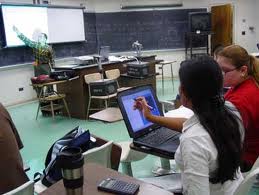Led by Gunther Kress, a group of scholars discusses the multimodal experiences that emerge in science classrooms and with significant implications for thinking about language across the discipline areas.

Several issues open out from this starting-point: if there are a number of distinct modes in operation at the same time (in our description and analysis we focus on speech, image, gesture, action with models, writing, etc.), then the first question is: ‘Do they offer differing possibilities for representing?’ For ourselves we put that question in these terms: ‘What are the affordances of each mode used in the science classroom; what are the potentials and limitations for representing each mode?’; and, ‘Are the modes specialized to function in particular ways. Is speech, let’s say, best for this, and image best for that?’ …
The regular use of action and image in the science classroom brings into immediate focus the issues raised in multimodal communication. The science classroom provides an environment where the shaping of students’ views of the world is not always ready-made, ‘of-the-cultural-shelf’; the shapings are often built within the environment of the classroom. Locating this study in the science classroom brings into sharp focus the need for an understanding of the semiotics of multimodal communication, because here the concrete material ‘stuff’ used in communicating the matter of science education cannot be ignored. The materials, chemicals, apparatus and models are imbued with meaning and thus force attention on the role of action in the learning process. Through a social semiotic analysis of the multimodal environment of the science classroom we hope to develop new understandings of learning in the science classrooms and in education generally. …
[L]anguage is widely taken to be the dominant mode of communication in learning and teaching. Image, gesture and action are generally considered illustrative supports to the ‘real thing’. Our observation of teaching and learning in the science classroom casts doubt on this assumption. In the teaching and learning of science it is common practice for teachers to use demonstration, experiment and images to explain phenomena, and to set tasks which require a visual or actional response, for example the production of concept maps, diagrams and three-dimensional models, and experiment or investigation. We suggest that the linguistic focus of much previous educational research on talk, reading, and writing in the classroom has been both an effect of this common sense and has served to confirm the dominant view of learning as a primarily linguistic accomplishment.
The increasing prevalence of multimodal tests (texts-as-objects which use more than one mode of meaning-making) and multimodal communication raises a crucial question: is an analytical procedure which attends to communication as a purely linguistic event capable of providing plausible accounts of the communicational function of such texts? ….
We are not suggesting that the realization of meanings through speech or writing is no longer important but that the visual is also important. Meaning-making, teaching and learning can no longer be considered as purely linguistic accomplishments. … Our approach challenges the deeply entrenched view that language is the central means of communication, that it is a full model for representation (that everything that needs to be conveyed can be using language), and that everything that can be through rationally can be expressed in language. In our approach it becomes clear that language, whether as speech or as writing, is only ever a partial means for carrying meaning. But if so, then which aspects of communication and representation does language as speech or writing deal with well (or at all) and which not? …
The assumption that communication is always multimodal and that all the modes are fully representational and communicational places a new question against speech and writing as modes and their role in representation and communication. They are partial in both and we need to examine that partiality. The emphasis in multimodality on the materiality of modes also issues a deep challenge to the abstract notions of language. Our emphasis throughout on speech and writing rather than on language is one attempt to draw attention to this issue.
Kress, Gunther, Carey Jewitt, Jon Ogborn, and Charalampos Tsatsarelis. Multimodal Teaching and Learning: The Rhetorics of the Science Classroom. London: Continuum, 2001, pp. 1, 10-11, 42, 142, 178. || Amazon || WorldCat
